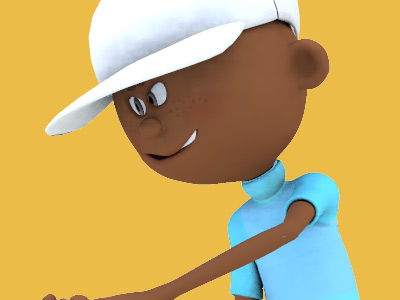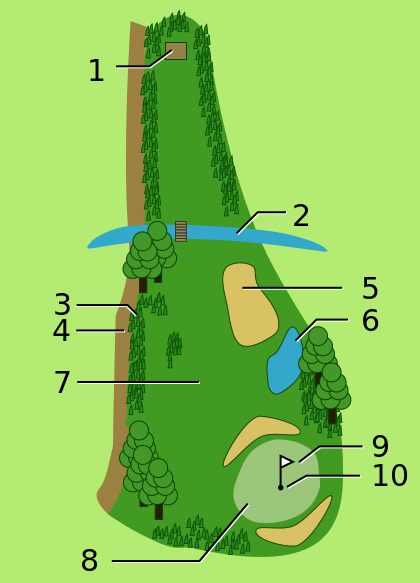Golf

Scoring
Par
A hole is classified by its par, meaning the number of strokes a skilled golfer should require to complete play of the hole. The minimum par of any hole is 3 because par always includes a stroke for the tee shot and two putts. Pars of 4 and 5 strokes are ubiquitous on golf courses; more rarely, a few courses feature par-6 and even par-7 holes. Strokes other than the tee shot and putts are expected to be made from the fairway; for example, a skilled golfer expects to reach the green on a par-4 hole in two strokes—one from the tee (the "drive") and another, second, stroke to the green (the "approach")—and then roll the ball into the hole in two putts for par. Putting the ball on the green with two strokes remaining for putts is called making "green in regulation" or GIR. Missing a GIR does not necessarily mean a golfer will not make par, but it does make doing so more difficult as it reduces the number of putts available; conversely, making a GIR does not guarantee a par, as the player might require three or more putts to "hole out". Professional golfers typically make between 60% and 70% of greens in regulation.
The primary factor for classifying the par of a relatively straight, hazard-free hole is the distance from the tee to the green. A typical par-3 hole is less than 250 yards (225 m) in length, with a par-4 hole ranging between 251 and 475 yards (225–434 m), and a par-5 hole being longer than 475 yards (435 m). The rare par-6s can stretch well over 650 yards (590 m). These distances are based on the typical scratch golfer's drive distance of between 240 and 280 yards (220 and 260 m); a green further than the average player's drive will require additional shots from the fairway. However, other considerations must be taken into account; the key question is "how many strokes would a scratch golfer take to make the green by playing along the fairway?". The grade of the land from the tee to the hole might increase or decrease the carry and rolling distance of shots as measured linearly along the ground. Sharp turns or hazards may require golfers to "lay up" on the fairway in order to change direction or hit over the hazard with their next shot. These design considerations will affect how even a scratch golfer would play the hole, irrespective of total distance from tee to green, and must be included in a determination of par. However, a par score never includes "expected" penalty strokes, as a scratch player is never "expected" to hit a ball into a water hazard or other unplayable situation. So, the placement of hazards only affect par when considering how a scratch golfer would avoid them.
Eighteen-hole courses typically total to an overall par score of 72 for a complete round; this is based on an average par of 4 for every hole, and so is often arrived at by designing a course with an equal number of par-5 and par-3 holes, the rest being par-4. Many combinations exist that total to par-72, and other course pars exist from 68 up to 76, and are not less worthy than courses of par-72. Additionally, in some countries including the United States, courses are classified according to their play difficulty, which may be used to calculate a golfer's playing handicap for a given course.
The two primary difficulty ratings in the U.S. are the Course Rating, which is effectively the expected score for a zero-handicap "scratch golfer" playing the course (and may differ from the course par), and the Slope Rating, which is a measure of how much worse a "bogey golfer" (with an 18 handicap) would be expected to play than a "scratch golfer". These two numbers are available for any USGA-sanctioned course, and are used in a weighted system to calculate handicaps.
Scoring
The goal is to play as few strokes per round as possible. A golfer's score is usually expressed as the difference between the player's number of strokes and the par score. A hole in one (or an "ace") occurs when a golfer sinks their ball into the cup with their first stroke from the tee. Common scores for a hole also have specific terms.
| Numeric term | Name | Definition |
|---|---|---|
| −4 | Condor | four strokes under par |
| −3 | Albatross (Double Eagle) | three strokes under par |
| −2 | Eagle | two strokes under par |
| −1 | Birdie | one stroke under par |
| E | Par | equal to par |
| +1 | Bogey | one stroke over par |
| +2 | Double bogey | two strokes over par |
| +3 | Triple bogey | three strokes over par |
In a typical professional tournament or among "scratch" amateur players, "birdie-bogey" play is common; a player will "lose" a stroke by bogeying a hole, then "gain" one by scoring a birdie. Eagles are uncommon but not rare; however, only 18 players have scored an albatross in a men's major championship.
There are two basic forms of golf play, match play and stroke play. Stroke play is more popular.
Match play
Two players (or two teams) play each hole as a separate contest against each other in what is called match play. The party with the lower score wins that hole, or if the scores of both players or teams are equal the hole is "halved" (or tied). The game is won by the party that wins more holes than the other. In the case that one team or player has taken a lead that cannot be overcome in the number of holes remaining to be played, the match is deemed to be won by the party in the lead, and the remainder of the holes are not played. For example, if one party already has a lead of six holes, and only five holes remain to be played on the course, the match is over and the winning party is deemed to have won "6 & 5". At any given point, if the lead is equal to the number of holes remaining, the party leading the match is said to be "dormie", and the match is continued until the party increases the lead by one hole or ties any of the remaining holes, thereby winning the match, or until the match ends in a tie with the lead player's opponent winning all remaining holes. When the game is tied after the predetermined number of holes have been played, it may be continued until one side takes a one-hole lead.
Stroke play
The score achieved for each and every hole of the round or tournament is added to produce the total score, and the player with the lowest score wins in stroke play. Stroke play is the game most commonly played by professional golfers. If there is a tie after the regulation number of holes in a professional tournament, a playoff takes place between all tied players. Playoffs either are sudden death or employ a pre-determined number of holes, anywhere from three to a full 18. In sudden death, a player who scores lower on a hole than all of his opponents wins the match. If at least two players remain tied after such a playoff using a pre-determined number of holes, then play continues in sudden death format, where the first player to win a hole wins the tournament.
Other forms of play
The other forms of play in the game of golf are bogey competition, skins, 9-points, stableford, team play, and unofficial team variations.
Bogey competition
A bogey competition is a scoring format sometimes seen in at informal tournaments. Its scoring is similar to match play, except each player compares their hole score to the hole's par rating instead of the score of another player. The player "wins" the hole if they score a birdie or better, they "lose" the hole if they score a bogey or worse, and they "halve" the hole by scoring par. By recording only this simple win-loss-halve score on the sheet, a player can shrug off a very poorly-played hole with a simple "-" mark and move on. As used in competitions, the player or pair with the best win-loss "differential" wins the competition.
Skins
A skins game is a variation on match play where each hole has an amount of money (the "skin") attached. This may be prize money at the professional level (the most famous event to use these rules was the "LG Skins Game", played at Indian Wells Golf Resort in California until 2008), or an amount wagered for each hole among amateur players. The player with the lowest score on the hole wins the skin for that hole; if two or more players tie for the lowest score, the skin carries over to the next hole. This continues until a player wins a hole outright, which may (and often does) result in a player receiving money for a previous hole that they had not tied for. If players tie the 18th hole, either all players or only the tying players repeat the 18th hole until an outright winner is decided for that hole (and all undecided skins).
9-Points
A nine-point game is another variant of match play typically played among threesomes, where each hole is worth a total of nine points. The player with the lowest score on a hole receives five points, the next-lowest score 3 and the next-lowest score 1. Ties are generally resolved by summing the points contested and dividing them among the tying players; a two-way tie for first is worth four points to both players, a two-way tie for second is worth two points to both players, and a three-way tie is worth three points to each player. The player with the highest score after 18 holes (in which there are 162 points to be awarded) wins the game. This format can be used to wager on the game systematically; players each contribute the same amount of money to the pot, and a dollar value is assigned to each point scored (or each point after 18) based on the amount of money in the pot, with any overage going to the overall winner.
Stableford
The Stableford system is a simplification of stroke play that awards players points based on their score relative to the hole's par; the score for a hole is calculated by taking the par score, adding 2, then subtracting the player's hole score, making the result zero if negative. Alternately stated, a double bogey or worse is zero points, a bogey is worth one point, par is two, a birdie three, an eagle four, and so on. The advantages of this system over stroke play are a more natural "higher is better" scoring, the ability to compare Stableford scores between plays on courses with different total par scores (scoring an "even" in stroke play will always give a Stableford score of 36), discouraging the tendency to abandon the entire game after playing a particularly bad hole (a novice playing by strict rules may score as high as an 8 or 10 on a single difficult hole; their Stableford score for the hole would be zero, which puts them only two points behind par no matter how badly they played), and the ability to simply pick up one's ball once it is impossible to score any points for the hole, which speeds play.
The USGA and R&A sanction a "Modified Stableford" system for scratch players, which makes par worth zero, a birdie worth 2, eagle 5 and double-eagle 8, while a bogey is a penalty of -1 and a double-bogey or worse -3. As with the original system, the highest score wins the game, and terrible scores on one or two holes won't wreck an entire game, but this system rewards "bogey-birdie" play more than the original, encouraging golfers to try to make the riskier birdie putt or eagle chipshot instead of simply parring each hole
Team Play
- Foursome: defined in Rule 29, this is played between two teams of two players each, in which each team has only one ball and players alternate playing it. For example, if players "A" and "B" form a team, "A" tees off on the first hole, "B" will play the second shot, "A" the third, and so on until the hole is finished. On the second hole, "B" will tee off (regardless who played the last putt on the first hole), then "A" plays the second shot, and so on. Foursomes can be played as match play or stroke play.
- Fourball: defined in Rules 30 and 31, this is also played between two teams of two players each, but every player plays their own ball and for each team, the lower score on each hole counts. Fourballs can be played as match play or stroke play.
Unofficial team variations
- Scramble: also known as ambrose or best-shot; each player in a team tees off on each hole, and the players decide which shot was best. Every player then plays their second shot from within a clublength of where the best shot has come to rest (and no closer to the hole), and the procedure is repeated until the hole is finished. This system is very common at informal tournaments such as for charity, as it speeds play (due to the reduced number of shots taken from bad lies), allows teams of varying sizes, and allows players of widely varying skill levels to participate without a profoundly negative impact on team score.
- Champagne scramble: a combination of a scramble and best-ball, only the first shot of each hole is a scramble; all players tee off, decide on the best tee shot, then each player plays their own ball starting at that point until they hole out, without deciding any further "best shots". The best score amongst the team's players is counted.
- Better ball or best-ball: like fourball, each player plays the hole as normal, but the lowest score of all the players on the team counts as the team's score for the hole.
- Greensome (also known as Scotch Foursomes): also called modified alternate shot, this is played in pairs; both players tee off, and then pick the best shot as in a scramble. The player who did not shoot the best first shot plays the second shot. The play then alternates as in a foursome. A variant of greensome is sometimes played where the opposing team chooses which of their opponent's tee shots the opponents should use. The player who did not shoot the chosen first shot plays the second shot. Play then continues as a greensome.
- Wolf (also known as Ship, Captain & Crew, Captain, Pig): a version of match play; with a foursome an order of play for each player is established for the duration of the round. The first player hits a ball from the tee, then waits for each successive player to hit (2nd, 3rd and 4th). After each player hits the 1st player has the option of choosing a partner for the hole (the 1st player is the Wolf for that hole) usually by calling Wolf before the next player hits. Once a partner is picked, each two-some (the Wolf and his or her partner vs the remaining two players) scores their total strokes and the winning two-some is awarded 1-point each for winning a hole and zero points for tying. The next hole, the rotation moves forward (e.g. the 2nd player is now hitting 1st and the Wolf and the previous Wolf hits last). A Wolf can decide to go alone to win extra points, but they must beat all other players in stroke play on that hole. If alone, the Wolf is awarded 2-points for going alone after everyone has hit or 4 points for declaring Lone Wolf before anyone else hits. If the Lone Wolf loses, to even one player, the 3 other players get 1-point each. The winner is the player with the most points at the end of the round. Strategically, care must be taken not to let a low-handicap player run away with all the points by being constantly paired with the Wolf.
Shotgun starts are mainly used for amateur tournament play. In this variant, each of the groups playing starts their game on a different hole, allowing for all players to start and end their round at roughly the same time. All 18 holes are still played, but a player or foursome may, for instance, start on hole 5, play through to the 18th hole, then continue with hole 1 and end on hole 4. This speeds the completion of the entire event as players are not kept waiting for progressive tee times at the first hole. This form of play, as a minor variation to stroke or match play, is neither defined nor disallowed by strict rules and so is used according to local rules for an event.
SPORTS

RESOURCES
This article uses material from the Wikipedia articles "Golf" and "Golf stroke mechanics", which is released under the Creative Commons Attribution-Share-Alike License 3.0.
© Stories Preschool. All Rights Reserved.









